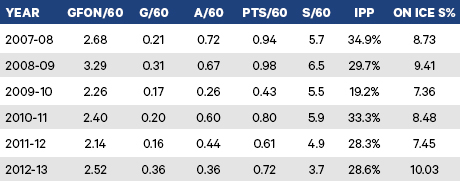So how much is the Maple Leafs captain worth, really? It’s a question that the future of a franchise may turn on.
Nick Kypreos’s report that Dion Phaneuf is looking for $50 million over seven years provides an excellent jumping off point for a discussion about how the introduction of a salary cap changed the distribution of money between players.
In the pre-2005 NHL, the distribution was very simple: the best players got significantly more money than the next tier of players. In 2003-04, three defencemen earned at least $9,000,000: Nicklas Lidstrom, Rob Blake and Chris Pronger. All three were past Norris Trophy winners. Pronger had the rare distinction of having won a Hart Trophy, something that had only been done by one other defenceman since the Second World War: Bobby Orr.
The gap between Lidstrom, Pronger and Blake and the next highest paid defenceman—Scott Stevens—was enormous: more than $2.4 million. Only nine defencemen made at least half of Lidstrom’s $10 million. Today, the highest cap hit in the NHL for a defenceman belongs to Shea Weber, at $7.857 million. More than 50 defencemen have a cap hit of at least half that amount. The pay scale for defencemen has become compressed. If you are a bona fide top-four defenceman who isn’t on an entry level contract, you’re probably making north of $3.5 million.
There’s an uncomfortable truth tied up in all of this: you can change how the money is allocated between players but that doesn’t create more star players. If you change the system so that Nick Lidstrom’s salary falls from $10 million to $7,857,143 and the 50th highest-paid defenceman sees his salary rise from $2.5 to $4 million, well, that’s really nice for the team that has Nick Lidstrom, and great for the 50th highest-paid defenceman. Unfortunately, it doesn’t make that defenceman any better relative to Lidstrom—it just makes him more expensive.
This has significant implications for building a team. If the price of top-four defencemen has risen dramatically and the price of elite defencemen has fallen, it means that it’s a lot easier now to spend a lot of money on a player who doesn’t make your team any better. At the same time, it means that truly elite defencemen are cheaper than ever—although you still have to fit them within the constraints of the salary cap.
Which leads to Phaneuf. The Maple Leafs now face a question in deciding whether or not to sign him: Is he really a star? To the observer versed in analytics, two things jump out of Phaneuf’s numbers, requiring some further investigation: the decline in his scoring since 2007-08 and the decline in his Corsi% (a player’s team’s shots, blocked shots, missed shots/all shots, blocked shots and missed shots when he is on the ice). I’ll talk about scoring this week and Corsi% next week.
Stats.hockeyanalysis.com has data going back to 2007-08. Conveniently, that was Phaneuf’s big offensive year in the NHL. It’s customary in hockey analytics to split data based on the game state (even strength, power play and penalty kill) and to then express it as a rate stat (per 60 minutes of play or per 20 minutes of play). This makes it easier to make apples-to-apples comparisons. Let’s look at some selected 5v5 data for Phaneuf from 2007-08 to 2012-13.
A brief explanation of those acronyms will probably be helpful. I’ll do this by explaining his 2007-08 stats line. In 2007-08, the Flames scored 2.68 goals per 60 minutes of 5v5 play with Phaneuf on the ice. He personally scored 0.21 goals per 60 minutes and added 0.72 points per 60 minutes for a total of 0.94 points per 60 minutes. He took 5.7 shots per 60 minutes of 5v5 play. He recorded points on 34.9 percent of Flames goals, a figure referred to in analytics as an Individual Points Percentage (IPP). Finally, the Flames shot 8.73 percent with him on the ice.
One of the big findings of hockey analytics is that players don’t have a particularly large degree of control over how many goals go in when they’re on the ice. This is particularly true of defencemen. If you think about how a hockey game works, it seems sensible; it’s unusual for a defenceman to be involved in an attack, other than by way of an outlet pass or shot from the point. After they touch the puck, it’s in the hands of the hockey gods.
Unfortunately for them, a defenceman’s point volume is tied up in how many goals his team scores when he is on the ice. The defenceman does have some impact on that—his ability to end opposition attacks and turn the puck up ice is significant—but it’s largely out of his hands. If you look at Phaneuf’s 5v5 pts/60, you’ll notice that they tend to go up and down with the 5v5 S%. In years where the team has a higher shooting percentage, Phaneuf tends to get more points.
The IPP number is also worth looking at. Hockey analytics researchers have found that this is a number that tends to move around, seemingly at random. Some years, it seems like every time a player touches the puck, his team scores; other years, his team might score lots but never when he’s in line to receive an assist. Whether it’s luck or something else, it doesn’t seem to matter too much—a player having an off year with IPP will both see his point totals fall and probably be fine the following year.
You can see that Phaneuf has had an off year with this stat—2009-10, the year in which he was traded to Toronto. He recovered from that just fine the following year and his 5v5 scoring recovered somewhat as well. It didn’t recover all the way though. In Phaneuf’s two full years in Calgary for which we have data, he scored 0.96 pts/60 at 5v5; in his three full seasons in Toronto, he scored 0.70 pts/60. That’s a very significant change—a defenceman who scores 0.96 pts/60 at 5v5 is an offensive star. One who scores 0.70 pts/60 has good, but not great, offensive production.
Why has Phaneuf’s 5v5 production fallen in Toronto? His G/60 is basically the same in his two elite years in Calgary and his three full seasons in Toronto—he scored 0.26 G/60 in his two big years with the Flames and 0.22 G/60 in his three full years in Toronto. That works out to an extra goal every 25 hours or so of 5v5 time in Calgary. That’s not a very big difference. The decline has been in his assists. In his last two full seasons with the Flames, he posted 0.70 A/60. In his three full seasons in Toronto, the number is 0.48 A/60.
The explanation for that decline lies in how much Phaneuf’s teams were able to shoot the puck in Calgary versus how much they do in Toronto. In his last two years in Calgary, Phaneuf’s teams took 32.8 shots per 60 minutes of 5v5 play. In Toronto, that fell to 27.7 shots per 60 minutes of 5v5 play. Fewer shots by his team means fewer goals scored, which means fewer assists. A player could be exactly the same player but if the players around him were worse—or if his team made tactical choices that reduced the number of shots his team generated—his numbers would decline.
In Phaneuf’s case, this decline in shots when he’s on the ice explains a lot of the decline in his 5v5 scoring. The question to which the Leafs front office should desperately be seeking an answer is whether that decline in shots is tied to some decline in Phaneuf, or a decline in the quality of the players around him from his time in Calgary to his time in Toronto.
If the answer is a decline in Phaneuf, the Leafs should be very leery of signing him to a big contract. If the answer has to do with the players around him or the tactical choices of the coach, then it’s fair to suspect that Phaneuf is an elite player in unusual circumstances who should be paid accordingly.
We’ll look into how data and analytics can help answer that question next week.



